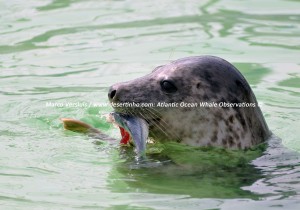Desertinho Atlantic Ocean – Is the Gray seal realy the great “White shark” of the Netherlands?
The bodies kept washing ashore, dozens of mutilated harbor porpoises stranded on the Dutch beaches, of the provinces of Zeeland and Zuid-Holland, every year, their bloody remains discovered by screaming vacationers. Now, after 10 years of crime scene investigation, style work, complete with autopsies and DNA testing, biologists and veterinary pathologists have finally cracked the identity of the murderers: big-eyed, chubby-faced gray seals. The finding could lead conservationists to rethink seal rehabilitation, and it even raises the specter of a new “great white” in the North Sea, Oosterschelde, and Westerschelde.
However, there is a flip site to that coin! Namely no one ever, not even in the Netherlands, has captured the hunt of a gray seal on a living porpoise at all. A healthy porpoise, especially in the North sea, is namely not an usaul pray for the gray seal at all. They are way to fast for the so called “Gray shark”. On the other hand porpoises that remain in the Oosterschelde and Westerschelde, they are sea arms of the North sea, are facing difficult circumstances to survive. These porpoises have to survive there in a sort of aquarium because of the Deltawerken (dike) and the fresh water rivers in the Netherlands where there is no fish for them at all. But, the gray seal has to deal with that same problem too in that area! Thats the reason why gray seals sometimes gnaw on a carcas of a porpoise. So please, dont call the gray seal the great white shark of the North sea, Oosterschelde, & Westerschelde, untill somebody shows up with real live evidence on camera.
Desertinho Atlantic Ocean – Is de Grijze zeehond wel de “Witte Haai” van de Noordzee, Oosterschelde, en Westerschelde?
De laatste jaren worden er boven gemiddeld veel gestrande, en verminkte, bruinvissen (Phocoena phocoena) gevonden in Nederland (Zeeland & Zuid-Holland). Direct komen er 2 vragen bij mij op: Ten eerste: “Waarom stranden er daar zoveel bruinvissen”, ten tweede: “Waarom zijn deze bruinvis kadavers daar verminkt”? Hierover verschijnen de wildste verhalen in de media. Gelukkig lijkt de “dader” gevonden namelijk: “De witte Haai” van de Noordzee, Oosterschelde, en Westerschelde of te wel de Grijze zeehond (Halichoerus grypus). Ik zelf heb daar sterke twijfels over. Tot nu toe heeft niemand de jacht waargenomen van een grijze zeehond op een gezonde bruinvis en dit vastgelegd op camera. Niet in de Noordzee, niet in de Oosterschelde, en ook niet in de Westerschelde.
Een gezonde bruinvis in de Noordzee is geen partij voor een grijze zeehond. Voor wat betreft bruinvissen in de Oosterschelde en Westerschelde kan dit een ander verhaal zijn. Deze bruinvissen zitten daar als het ware opgesloten en kunnen, door gebrek aan voedsel, verzwakt zijn. Daarnaast hebben deze bruinvissen te leiden onder de scheepvaart in dat gebied welke geluidsvervuiling veroorzaakt. Hierdoor kan het inderdaad zo zijn dat een grijze zeehond het kadaver van een bruinvis, in dat gebied, zal aanvreten. Ook de grijze zeehond heeft in dat gebied te maken met een gebrek aan natuurlijk voedsel. Tot slot: Er is geen enkel bewijs van de jacht van een grijze zeehond op een bruinvis. Zelfs niet in het opgesloten gebied als dat van de Oosterschelde en Westerschelde.
